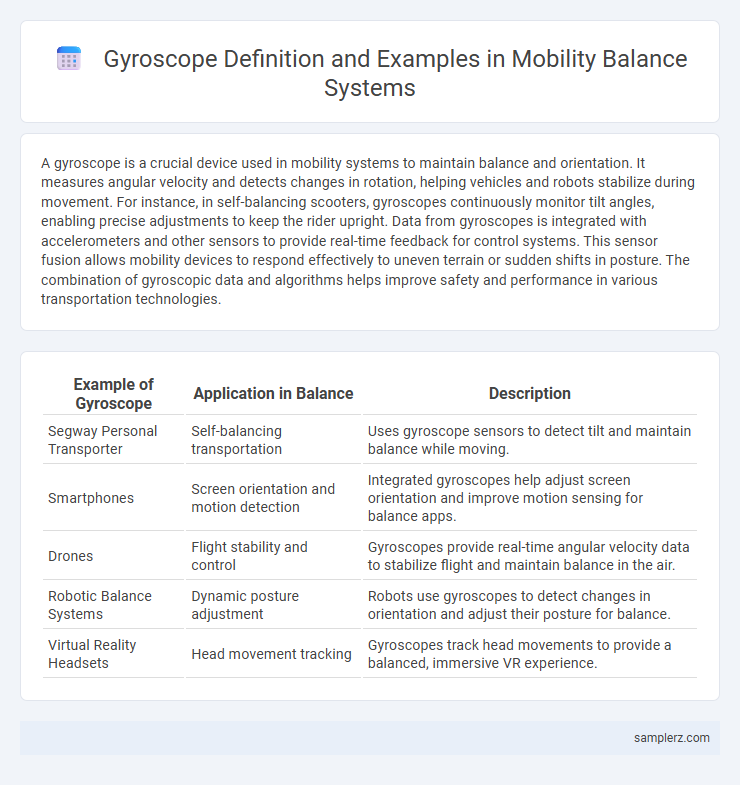A gyroscope is a crucial device used in mobility systems to maintain balance and orientation. It measures angular velocity and detects changes in rotation, helping vehicles and robots stabilize during movement. For instance, in self-balancing scooters, gyroscopes continuously monitor tilt angles, enabling precise adjustments to keep the rider upright. Data from gyroscopes is integrated with accelerometers and other sensors to provide real-time feedback for control systems. This sensor fusion allows mobility devices to respond effectively to uneven terrain or sudden shifts in posture. The combination of gyroscopic data and algorithms helps improve safety and performance in various transportation technologies.
Table of Comparison
| Example of Gyroscope | Application in Balance | Description |
|---|---|---|
| Segway Personal Transporter | Self-balancing transportation | Uses gyroscope sensors to detect tilt and maintain balance while moving. |
| Smartphones | Screen orientation and motion detection | Integrated gyroscopes help adjust screen orientation and improve motion sensing for balance apps. |
| Drones | Flight stability and control | Gyroscopes provide real-time angular velocity data to stabilize flight and maintain balance in the air. |
| Robotic Balance Systems | Dynamic posture adjustment | Robots use gyroscopes to detect changes in orientation and adjust their posture for balance. |
| Virtual Reality Headsets | Head movement tracking | Gyroscopes track head movements to provide a balanced, immersive VR experience. |
Introduction to Gyroscopes in Mobility
Gyroscopes play a crucial role in enhancing balance and stability in mobility devices such as electric scooters and autonomous robots. These sensors detect angular velocity, enabling real-time adjustments to maintain equilibrium on uneven terrain. Incorporating gyroscopic technology improves safety and performance by providing precise orientation feedback for dynamic movement control.
How Gyroscopes Aid in Balance
Gyroscopes enhance balance by detecting angular velocity and orientation changes, enabling precise motion sensing in devices like smartphones, drones, and wearable fitness trackers. Their ability to measure rotational movement helps stabilize systems by providing real-time feedback for automatic adjustments. This sensory input supports advanced applications in robotics, virtual reality, and mobility aids, improving stability and control during movement.
Gyroscope Applications in Electric Scooters
Gyroscopes in electric scooters play a critical role in maintaining balance and stability by detecting angular velocity and orientation changes in real-time. These sensors enable precise control of the scooter's self-balancing mechanism, improving rider safety and smoothness of the ride. Advanced gyroscope integration enhances maneuverability, especially on uneven terrain and during sharp turns, making electric scooters more reliable and user-friendly.
Gyroscopes in Self-Balancing Hoverboards
Gyroscopes play a crucial role in maintaining balance in self-balancing hoverboards by continuously detecting angular velocity and orientation changes. These sensors provide real-time feedback to the hoverboard's control system, enabling automatic adjustments to motor speed and direction for stable movement. High-precision MEMS (Micro-Electro-Mechanical Systems) gyroscopes enhance user safety and riding experience through accurate stabilization on varying terrains.
Role of Gyroscopes in Modern Segways
Gyroscopes play a critical role in maintaining balance and stability in modern Segways by continuously detecting angular velocity and orientation changes. This real-time sensor data enables the Segway's control system to make precise adjustments to the motors, ensuring smooth motion and preventing tipping. Advanced MEMS gyroscopes are integral to the Segway's dynamic stabilization, improving rider safety and enhancing overall mobility efficiency.
Gyroscope Integration in Autonomous Vehicles
Gyroscopes play a critical role in autonomous vehicles by providing precise orientation and angular velocity data essential for accurate navigation and stability control. The integration of MEMS gyroscopes enhances real-time balance and maneuverability, allowing vehicles to maintain equilibrium during complex driving conditions such as sharp turns and uneven terrain. This precise motion sensing technology supports advanced driver-assistance systems (ADAS) and improves overall safety by enabling rapid response to dynamic environments.
Enhancing Balance in Bicycles with Gyroscopes
Gyroscopes enhance balance in bicycles by providing real-time angular velocity data, allowing electronic systems to stabilize the bike during turns and uneven terrain. This technology improves rider control by detecting changes in orientation and adjusting the bike's posture to prevent tipping. Advanced gyroscopic sensors integrated into modern bicycles contribute significantly to safer and more stable riding experiences.
Wearable Gyroscope Devices for Mobility Assistance
Wearable gyroscope devices play a crucial role in enhancing mobility assistance by providing real-time balance feedback to users, particularly individuals with impaired motor function. These devices utilize gyroscopic sensors to detect angular velocity and orientation changes, enabling precise monitoring of body movements and improving stability during walking or standing. Integration of wearable gyroscopes in mobility aids, such as smart insoles or balance belts, significantly reduces the risk of falls and supports rehabilitation through continuous motion tracking and analysis.
Gyroscopes in Robotics for Stability
Gyroscopes in robotics play a critical role in maintaining balance and stability by accurately measuring angular velocity and orientation. These sensors enable robots to adjust their posture in real-time, preventing falls and enhancing precise movements in dynamic environments. Advanced inertial measurement units (IMUs) integrating gyroscopes improve robotic navigation, especially in bipedal robots and autonomous vehicles.
Future Innovations: Gyroscopes Transforming Mobility
Gyroscopes are revolutionizing mobility by enabling advanced balance control in autonomous vehicles and wearable exoskeletons. Future innovations leverage high-precision microelectromechanical systems (MEMS) gyroscopes to enhance stability, navigation, and real-time motion sensing. Integration of AI-powered gyroscopes is driving breakthroughs in adaptive balance systems, improving safety and efficiency in next-generation transportation and personal mobility devices.

example of gyroscope in balance Infographic
 samplerz.com
samplerz.com